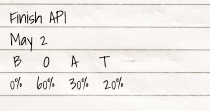- Home >
- Fork The System>
- BOAT Estimate
B.O.A.T. Estimate
The Boat estimate is a technique to evaluate an estimated completion date. It is very helpful in evaluating confidence in an estimate and is helpful in exposing many anti-patterns in estimates.
Let's walk through an example and the 3 steps to doing a BOAT.
Step 1: Pick a date
Choose a date on which you plan to commit. There are a variety of techniques to do this, but they are beyond the scope of this post. If you do not have a date, write down your best guess.
For my API, I think it will be done by May 2.
Step 2: Write "B O A T"
Write out – B O A T – Before, On-time, After, and Terrible.
- Before means you will finish more than a week early.
- On-time means you will finish within a week of your desired date.
- After means you will be one or two weeks late.
- Terrible means you will be more than 3 weeks late.
If the desired date is less than a few months out then scale down (“before” becomes a few days early), or if it is over a year then scale up (“before” becomes a few weeks early). Don’t spend much time thinking about the precise cut-off.
Step 3: Estimate your Confidence
For each category estimate the percent chance that the project will be completed in the desired timeframe.
So for my API date, there’s a chance that we’ll finish early, but not a big chance.
Plus this client often brings in new priorities, so that adds to the risk that it will be late. But the work is well known so I do not see many big chances for it to blow up. So I think there is a 20% chance we will finish early, 30% on time, 40% a little late, and 10% chance that we will be really late.
Rules to Keep in Mind
Rule 1: Do not be precise
This is a gut check! There is no way you are 23.567% sure that it will be on time. Therefore, only use increments of 10% (e.g. 0% 10% 20% 30%, etc). I also like to allow a <1%, for the occasion when you can’t quite say 0%. The lack of precision helps prevent nitpicking at the margins; it is difficult to nitpick when moving 10% at a time.
Rule 2: Forget about the details
Just like we are trying not to be too precise, don’t be too specific. We often try and break big things down into smaller things that we feel like we can estimate, and then just add up those estimates, but that is not how life works. Just because one can swim 1.5k in 25 mins, bike 40k in 60 mins and run 10k in 35 mins does not mean they can do a triathlon in 2 hours. This is your chance to think big.
Rule 3: No assuming away risks
I used this exercise with a Project Manager and he thought for a second and then started assuming. “Assuming we get the team we want, and there is no feature scope creep, and the designer delivers on time, and the third party vendor has good documentation…”
This reminded me of an old economist joke:
format_quoteformat_quote
An economist is trapped on a deserted island with some other people. They have nothing, but a shipment of canned foods. The others turn to him and ask what should we do to get the food? He replies “Well first let’s assume we have a can opener.”
Old bad joke
If we could assume away all risks, estimating would be so easy it would not be fun. Think about the risks and the chance they will happen and how that would affect the chance of project/software delivery. Keep the risks and put them in your estimate. That is where they belong.
Ok, give it try, and then we can talk about the different results.
Evaluating the Results
Now that you have your BOAT what does it mean? Here are a few common outcomes and help on what they mean.
Sit Down, you're rocking the BOAT
If you have supermajorities in B or T like so:
Then there is a good chance you have the wrong date and you should start over with the date close to the supermajority. That second scenario can pose real trouble when a salesperson sees it and says “So you are telling me there’s a chance”. Don’t give them the opportunity, re-estimate.
If you can't be early, you will never be on time.
If your estimate does not allow any possibility of being early then your completion date is too early.
If you can’t be early even if all the stars align, then you’re relying on all the stars to align for you to just be on time.
This is not the situation on which you should rely.
Think about your friends, the ones that are on time, they are always the ones that are early some of the time.
Commitment dates are not coin flips
Whenever your estimate has only a 50% chance of B+O, it might seem like you have hit it perfectly.
But deadlines are not the average date of delivery. People expect a much higher chance of success.
In reality, anything less than 70% in the B+O category is problematic, and for some risk-averse clients I would even say 80% is on the edge.
Countdown to Success
When the BOAT starts high with B and gets smaller and small, then we have a reasonable deadline date.
Finishing up
This method can also be a great exercise for a team to do. Much like Planning Poker it can help to allow us all to see each others perspective. Estimatethisfor.me is a web app that can help facilitate such activity.
©Erik Summerfield 2025
e2thex.org Last Updated: 7/11/2025







